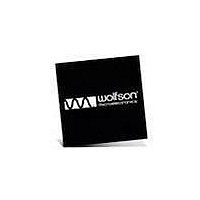WM8352GEB/V Wolfson Microelectronics, WM8352GEB/V Datasheet - Page 55

WM8352GEB/V
Manufacturer Part Number
WM8352GEB/V
Description
Audio CODECs Audio CODEC plus pwr management
Manufacturer
Wolfson Microelectronics
Datasheet
1.WM8352GEBV.pdf
(335 pages)
Specifications of WM8352GEB/V
Number Of Adc Inputs
2
Number Of Dac Outputs
2
Conversion Rate
48 KSPS
Interface Type
Serial (2-Wire, 3-Wire, 4-Wire)
Resolution
12 bit
Operating Supply Voltage
3.7 V
Maximum Operating Temperature
+ 85 C
Mounting Style
SMD/SMT
Package / Case
BGA
Minimum Operating Temperature
- 25 C
Number Of Channels
2 ADC/2 DAC
Supply Current
260 uA
Thd Plus Noise
- 83 dB
Audio Codec Type
Stereo
No. Of Adcs
2
No. Of Dacs
2
No. Of Input Channels
8
No. Of Output Channels
6
Adc / Dac Resolution
24bit
Adcs / Dacs Signal To Noise Ratio
95dB
Rohs Compliant
Yes
Lead Free Status / RoHS Status
Lead free / RoHS Compliant
- Current page: 55 of 335
- Download datasheet (3Mb)
Production Data
12.4 FLL
w
12.3.5
When the GPIO5 pin is configured as CODEC_OPCLK, a clock derived from SYSCLK may be output
on this pin to provide clocking for other parts of the system. The frequency of this signal is derived
from SYSCLK and determined by OPCLK_DIV, as described in Table 14.
Table 14 OPCLK Control
12.3.6
A slow clock derived from SYSCLK may be generated for de-bouncing of the Headphone Jack
Detect function or to set the timeout period for volume updates when zero-cross functions are used.
This clock is enabled by TOCLK_ENA and its frequency is set by TOCLK_RATE, as described in
Table 15.
Table 15 SLOWCLK Control
The integrated FLL can be used to generate SYSCLK from a wide variety of different reference
sources and frequencies. The FLL can accept a wide range of reference frequencies, which may be
high frequency (eg. 12.288MHz) or low frequency (eg. 32.768kHz). The FLL is tolerant of jitter and
may be used to generate a stable SYSCLK from a less stable input signal.
The FLL can take as input the external MCLK, or ADCLRCLK / DACLRCLK (in Slave modes), or the
32kHz crystal oscillator (or external 32kHz source). The FLL input reference source is selected using
the FLL_CLK_SRC, as described in Table 17. Choosing the 32kHz source as an input selects either
the 32kHz GPIO input or the internal 32kHz oscillator, as illustrated in Figure 33. For best audio
performance, it is recommended that a high frequency input clock (above 1MHz) is used.
The analogue and digital portions of the FLL may be enabled independently via FLL_OSC_ENA and
FLL_ENA. When initialising the FLL, the analogue circuit must be enabled first by setting
FLL_OSC_ENA. The digital circuit may then be enabled on the next register write or later. When
changing FLL settings, it is recommended that the digital circuit be disabled via FLL_ENA and then
re-enabled after the other register settings have been updated. When changing the input reference
frequency F
R40 (28h)
Clock Control
1
R11 (0Bh)
Power Mgmt
4
R40 (28h)
Clock Control
1
Note: TOCLK_ENA can be accessed through R11 or through R40. Reading from or writing to either
register location has the same effect.
REGISTER
REGISTER
ADDRESS
ADDRESS
OPCLK CONTROL
SLOWCLK CONTROL
REF
, it is recommended that the FLL be reset by setting FLL_ENA to 0.
BIT
15
14
BIT
8
2:0
TOCLK_ENA
TOCLK_RATE
OPCLK_DIV
[2:0]
LABEL
LABEL
DEFAULT
DEFAULT
0
0
000
Slow clock enable. Used for both the
jack insert detect debounce circuit and
the zero cross timeout.
0 = slow clock disabled
1 = slow clock enabled
Slow Clock Selection (Used for volume
update timeouts and for jack detect
debounce)
0 = SYSCLK / 2^21 (Slower Response)
1 = SYSCLK / 2^19 (Faster Response)
OPCLK Frequency (GPIO function)
000 = SYSCLK
001 = SYSCLK / 2
010 = SYSCLK / 3
011 = SYSCLK / 4
100 = SYSCLK / 5.5
101 = SYSCLK / 6
110 = Reserved
111 = Reserved
DESCRIPTION
DESCRIPTION
PD, March 2010, Rev 4.2
WM8352
55
Related parts for WM8352GEB/V
Image
Part Number
Description
Manufacturer
Datasheet
Request
R

Part Number:
Description:
Wolfson Audioplus? Stereo Codec With Power Management
Manufacturer:
Wolfson Microelectronics plc
Datasheet:

Part Number:
Description:
Audio IC Development Tools WM8352 MINI EVAL BOARD
Manufacturer:
Wolfson Microelectronics
Datasheet:

Part Number:
Description:
Audio IC Development Tools WM8352 FULL EVAL SYSTEM
Manufacturer:
Wolfson Microelectronics
Datasheet:

Part Number:
Description:
Manufacturer:
Wolfson Microelectronics
Datasheet:










